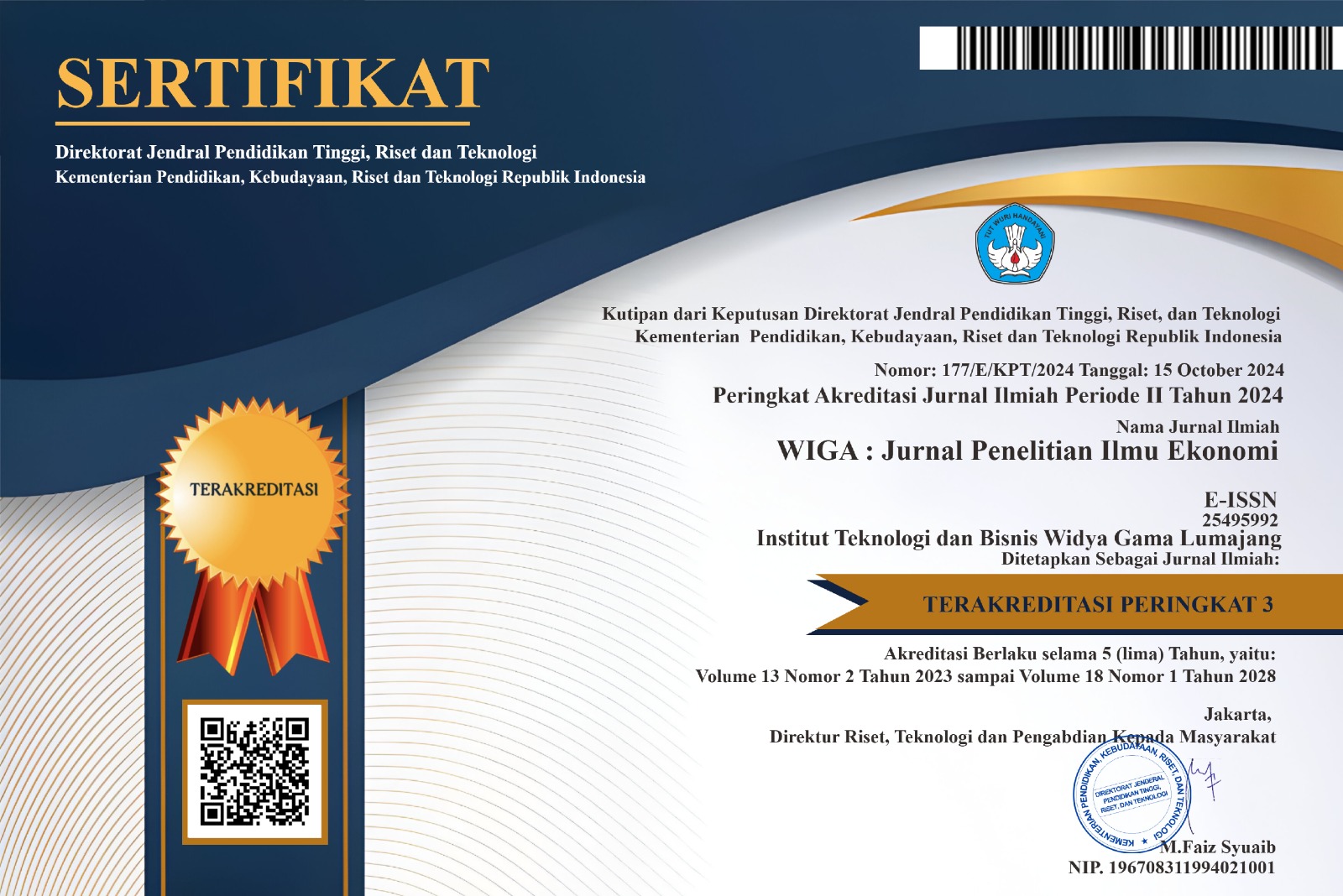Repurchase Intention of Gen Z on Shopee Marketplace: A Technology Acceptance Model Approach
DOI:
https://doi.org/10.30741/wiga.v15i2.1564Keywords:
Perceived Usefulness (PU), Perceived Ease of Use (PEOU), Satisfaction and Repurchase IntentionAbstract
E-commerce has reshaped shopping behavior, especially among Generation Z, who prioritize convenience and speed. While Shopee continues to improve the user experience, it faces challenges in maintaining satisfaction and loyalty among this selective and promotion-sensitive group. This study investigates how perceived usefulness (PU), perceived ease of use (PEOU), and satisfaction influence repurchase intention within the Technology Acceptance Model (TAM) framework. A total of 182 Gen Z respondents from Lumajang, who had used Shopee in the past six months, were selected using purposive sampling. Data were analyzed using Structural Equation Modeling with the Partial Least Squares (PLS-SEM) approach. The data testing procedure included convergent validity, discriminant validity, and reliability testing to ensure the accuracy and consistency of measurement instruments. This was followed by structural model evaluation using R² and Q² values, as well as hypothesis testing through path coefficient analysis to assess the significance of the relationships among variables. The results revealed that most respondents were female (69.8%) and aged 20–21 years, with the majority having used Shopee more than five times. PU and PEOU significantly affect satisfaction and repurchase intention, while satisfaction mediates the relationship between PU, PEOU, and repurchase intention. These findings highlight the essential role of user experience in fostering repurchase behavior among Gen Z Shopee users.
Downloads
References
Ahdiat, A. (2023). Jumlah Kunjungan ke 5 Situs E-Commerce Terbesar di Indonesia (Januari-September 2023)*. Databoks. https://databoks.katadata.co.id/datapublish/2023/10/11/pengunjung-shopee-makin-banyak-bagaimana-e-commerce-lain
Annur, Ci. M. (2023). Intensitas Belanja Online dan Offline Berdasarkan Kelompok Usia (Desember 2022). Katadata Insight Center (KIC). https://databoks.katadata.co.id/datapublish/preview/2023/04/17/survei-kic-tren-belanja-online-lebih-kuat-di-kalangan-gen-z-ketimbang-milenial-hold
Aparicio, M., Costa, C. J., & Moises, R. (2021). Gamification and reputation: key determinants of e-commerce usage and repurchase intention. Heliyon, 7(3), e06383. https://doi.org/10.1016/j.heliyon.2021.e06383
Ashfaq, M., Yun, J., Waheed, A., Khan, M. S., & Farrukh, M. (2019). Ekspektasi , Kepuasan , dan Niat Pembelian Ulang Produk Bekas Secara Online : Bukti Empiris dari Tiongkok. https://doi.org/10.1177/2158244019846212
Chen, C. C. V., & Chen, C. ou. (2017). Management Decision The role of customer participation for enhancing repurchase intention Article information. Management Decision, 55(3), 547–562.
Cuong, D. T. (2023). Determinants affecting online shopping consumers ’ satisfaction and repurchase intention : Evidence from Vietnam. Innovative Marketing, 19(1), 126–139. https://doi.org/10.21511/im.19(1).2023.11
Damayanti, D. (2021). The Effect of Technology of Acceptance Model on the Gojek 4 . 0 Application on Repurchase Intention. Jurnal Mantik, 5(36), 1147–1152.
Davis, F. D. (1989). Perceived Usefulness, Perceived Ease of Use, and User Acceptance of Information Technology. Management Information Systems Research Center, 13(3), 319–340.
Faizah, N., & Sanaji, S. (2022). Pengaruh perceived ease of use dan perceived usefulness terhadap loyalitas dengan trust sebagai variabel intervening terhadap penggunaan aplikasi warung pintar. Jurnal Ilmu Manajemen, 10(3), 946–959.
Fernandes, N., & Barfknecht, C. (2020). Cogent Business & Management Keep customers coming back : Enhancing value and satisfaction in a mobile shopping application context Keep customers coming back : Enhancing value and satisfaction in a mobile shopping application context. Cogent Business & Management, 7(1), 1–22. https://doi.org/10.1080/23311975.2020.1788874
Ghozali, I. (2016). Aplikasi Analisis Multivariate dengan Program SPSS 23. Badan Penerbit Universitas Diponegoro.
Hair, J., Black, W., Babin, B., & R.E, A. (2019). Multivariate Data Analysis. Pearson.
Hair, J. F., Hult, G. T., Ringle, C., & Sarstedt, M. (2017). A Primer on Partial Least Squares Structural Equation Modeling (PLS-SEM) - Joseph F. Hair, Jr., G. Tomas M. Hult, Christian Ringle, Marko Sarstedt. In Sage.
Halim, E., Hebrard, M. T., Laurent, C., & Kurniawan, Y. (2022). The Impact of Customer Satisfaction and Customer Trust to Repurchase Intention in Purchasing Digital Product at the Marketplace. International Seminar on Intelligent Technology and Its Applications (ISITIA), 181–186. https://doi.org/10.1109/ISITIA56226.2022.9855299.
Hasan, A. (2018). Marketing dan Kasus-Kasus Pilihan. Media Pressindo.
Havidz, H. B. H., Hudaya, A., & Ali, H. (2020). Model Of Consumer Trust On Travel Agent Online: Analysis Of Perceived Usefulness And Security On Re- Purchase Interests (Case Study Tiket.Com). Dinasti International Journal of Economics, Finance & Accounting, 1(1), 110–124. https://doi.org/10.38035/DIJEFA
Hidajat, K., & Setiawan, R. A. (2022). keputusan belanja : peran moderasi kepercayaan pelanggan. MBR (Management and Business Review), 6(1), 102–112.
Indrasari, M. (2019). Pemasaran dan Kepuasan Pelanggan. Unitomo Press.
Kim, D., & Kim, H.-Y. (2022). Social media influencers as human brands: an interactive marketing perspective. Journal of Research in Interactive Marketing, ahead-of-p. https://doi.org/10.1108/JRIM-08-2021-0200
Kotler, P., & Keller, K. L. (2016). Marketing Management. Global Edition 15. Pearson education.
Kotler, P., & Keller, K. L. (2021). Manajemen Pemasaran (13th ed.). Indeks kelompok Gramedia.
Kuswanadji, A., Kuswardani, D. C., & Utaminingsih, A. (2024). Perceived Usefulness And Ease Of Use On The Intention To Reuse ( Study On The Use Of The New Sakpole Application ) Analisis Pengaruh Perceived Ease Of Use Dan Perceived Usefulness Terhadap Reuse Intention Dengan Customer Satisfaction Sebagaik Variabel Int. Management Studies and Entrepreneurship Journal, 5(2), 3946–3954.
Nuralam, I. P., Yudiono, N., Fahmi, M. R. A., Yuliaji, E. S., & Hidayat, T. (2024). Perceived ease of use, perceived usefulness, and customer satisfaction as driving factors on repurchase intention: the perspective of the e-commerce market in Indonesia. Cogent Business & Management, 11(1). https://doi.org/https://doi.org/10.1080/23311975.2024.2413376
Redaksi, J. (2023). Beginilah Perilaku Belanja Gen Z: Tak Loyal Pada Merek! Redaksi News Room. https://j5newsroom.com/2023/07/12/beginilah-perilaku-belanja-gen-z-tak-loyal-pada-merek/
Saraswati, I. G. A. A. P., & Rahyuda, I. K. (2021). engaruh Perceived Ease Of Use , Perceived Usefulness Dan Trust Terhadap Repurchase Intention. E-Jurnal Ekonomi Dan Bisnis Universitas Udayana, 10(02), 61–72.
Sudaryanto, S., Ari, S., & Meliana, M. (2021). Does COVID-19 Affect Online Experience Towards Repurchase Intention? An Empirical Study in Indonesia*. Journal of Asian Finance, 8(6), 1013–1023. https://doi.org/10.13106/jafeb.2021.vol8.no6.1013
Sudaryanto, S., Subagio, A., & Meliana, M. (2021). Does COVID-19 Affect Online Experience Towards Repurchase Intention ? An Empirical Study in Indonesia * Does COVID-19 Affect Online Experience Towards Repurchase Intention ? An Empirical Study in Indonesia *. Journal of Asian Finance Economics and Business, 8(6), 1013–1023. https://doi.org/10.13106/jafeb.2021.vol8.no6.1013
Tjiptono, F., & Diana, A. (2020). Pemasaran. ANDI.
Trivedi, S. K., & Yadav, M. (2020). Repurchase intentions in Y generation : mediation of trust and e-Satisfaction. Marketing Intelligence & Planning, 38(4), 401–415. https://doi.org/10.1108/MIP-02-2019-0072
Utamanyu, R. A., & Darmastuti, R. (2022). Budaya Belanja Online Generasi Z Dan Generasi Milenial Di Jawa Tengah (Studi Kasus Produk Kecantikan di Online Shop Beauty by ASAME). Scriptura, 12(1), 58–71. https://doi.org/10.9744/scriptura.12.1.58-71
Venkatesh, V., & Davis, F. D. (2000). Theoretical extension of the Technology Acceptance Model: Four longitudinal field studies. Management Science, 46(2), 186–204. https://doi.org/10.1287/mnsc.46.2.186.11926
Wafiyyah, R. S., & Kusumadewi, N. M. W. (2021). The Effect of Perceived Usefulness, Perceived Ease Of Use, And Trust On Repurchase Intention On E Commerce Shopee. International Journal of Innovative Science, Engineering & Technology (IJISET), 8(7), 428–434. www.ijiset.com
Wahyuningtyas, Y. F., & Widiastuti, D. A. (2015). Analisis Pengaruh Persepsi Risiko, Kemudahan Dan Manfaat Terhadap Keputusan Pembelian Secara Online (Studi Kasus Pada Konsumen Barang Fashion Di Facebook). Jurnal Kajian Bisnis, 23(2), 112–120.
Wen, C., Prybutok, V. R., & Xu, C. (2011). An integrated model for customer online repurchase intention. Taylor & Francis, 23(1), 1–19. http://www.tandfonline.com/doi/abs/10.1080/08874417.2011.11645518%0Ahttp://thekeep.eiu.edu/business_fac%0Ahttp://thekeep.eiu.edu/business_fac/8
Wilson, N., Alvita, M., & Wibisono, J. (2021). The Effect Of Perceived Ease Of Use And Perceived Security Toward Satisfaction And Repurchase Intention. Jurnal Muara Ilmu Ekonomi Dan Bisnis, 5(1), 145–159.
Wilson, N., Keni, K., Henriette, P., & Tan, P. (2021). The Role of Perceived Usefulness and Perceived Ease-of-Use Toward Satisfaction and Trust which Influence Computer Consumers ’ Loyalty in China. Gadjah Mada International Journal of Business, 23(3), 262–294.
Yeo, S. F., Tan, C. L., Teo, S. L., & Tan, K. H. (2021). The role of food apps servitization on repurchase intention: A study of FoodPanda. International Journal of Production Economics, 234(December 2020), 108063. https://doi.org/10.1016/j.ijpe.2021.108063
Zhang, Z., & Nuangjamnong, C. (2022). The Impact Factors toward Online Repurchase Intention: A case study of Taobao e-Commerce platform in China. International Research E-Journal on Business and Economics, 7(2), 35–56. https://www.qianzhan.com/analyst/detail/220/220407-55e33cd2.html
Downloads
Published
How to Cite
Issue
Section
License
Copyright (c) 2025 Ayu Febriyanti Dewi Rahmawati, Sudaryanto, Hadi Paramu

This work is licensed under a Creative Commons Attribution-NonCommercial 4.0 International License.










